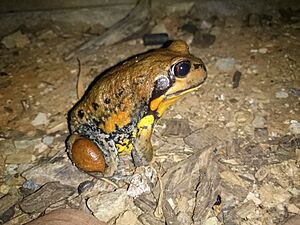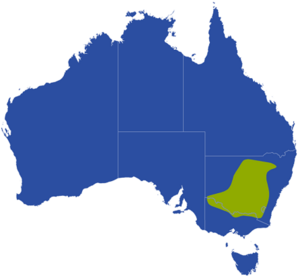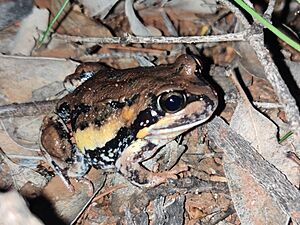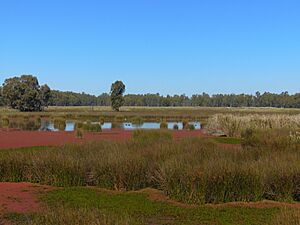Giant banjo frog facts for kids
Quick facts for kids Giant banjo frog |
|
|---|---|
 |
|
| Conservation status | |
| Scientific classification | |
 |
|
| Distribution of the Giant Banjo Frog |
The giant banjo frog is a special type of frog found only in Australia. It's also known as the giant pobblebonk frog or giant bullfrog. Its scientific name is Limnodynastes interioris. This frog belongs to the Limnodynastidae family. Scientists first recognized it as a unique kind of banjo frog. It's different from the similar Southern or Eastern Banjo Frogs, which live across eastern Australia.
Contents
What Does the Giant Banjo Frog Look Like?
The Giant Banjo Frog can grow to be about 7 to 9 centimeters long. That's roughly the length of a small smartphone! Its back is usually brown with black spots and feels bumpy. But its belly is smooth and can be pale or bright yellow.
The sides of its body are reddish-brown or fawn, with black and gray specks. A black stripe runs from its nose down its sides. Its eyes have dark gold specks and a horizontal pupil. Its front feet don't have webs between the toes. The back feet are partly webbed. Each back foot has a large, shovel-shaped bump underneath. This bump helps the frog dig. Its strong toes are perfect for burrowing deep into the soil.
The eggs of the Giant Banjo Frog are dark. They are laid in a big foamy mass in flooded burrows. This foam mass is often surrounded by plants. The tadpoles are quite big, growing up to 9.5 centimeters long. They are dark brown or black with gold spots and dark gray fins.
Where Do Giant Banjo Frogs Live?
The Giant Banjo Frog lives only in Australia. You can find it in the dry areas of central New South Wales and northern Victoria. It mostly lives in the Murray-Darling Basin and the areas that flood near the Murray River. The total area where these frogs live is huge, about 214,800 square kilometers!
How Many Giant Banjo Frogs Are There?
There are many Giant Banjo Frogs, and their numbers are stable. Because of this, they are listed as a species of "least concern." This means they are not currently in danger of disappearing. However, their homes are at risk. Changes to the water flow in the Murray-Darling Basin can harm the frog communities that live there.
Interestingly, a type of fish called the Common Carp seems to help these frogs. Scientists think the carp might reduce the number of animals that eat Giant Banjo Frog tadpoles.
What Kind of Home Do They Like?
Giant Banjo Frogs spend most of their time underground. They usually only come out after it rains to find food and lay eggs. Their favorite places to live are near freshwater floodplains, marshes, swamps, and ponds. But you can also find them in dry forests, grasslands, and savannas.
Unlike many other frogs that live in dry places, the Giant Banjo Frog spends a lot of its life in water. Their eggs are laid in water, often in flooded burrows, dams, swamps, and ponds. The tadpoles live in water that is still or moves very slowly. These frogs are found more often in permanent wetlands away from the main river. They like places with lots of different plants.
What Do Giant Banjo Frogs Eat?
The Giant Banjo Frog is a carnivore, which means it eats meat. Adult frogs eat many kinds of insects, worms, and spiders. The plants and hiding spots in their habitat provide lots of places for these food sources to live.
How Do They Survive Dry Times?
When there are long periods without rain, Giant Banjo Frogs have a special way to survive. They have strong, shovel-shaped legs that help them dig deep into the ground. This is a great adaptation for frogs living in dry areas with changing rainfall. Being able to dig deep and having a larger body helps them handle the dry climate. This also means they are less likely to be affected by future climate change. These frogs don't form a special "cocoon" like some other frogs. Instead, they just dig deeper to stay moist during dry spells.
Life Cycle and Reproduction
How Long Do They Live?
Giant Banjo Frogs can live for about 10 years in the wild. During hot and dry months, they go into a state of dormancy called aestivation. This is like a long sleep where they save energy and stay safe underground.
Nesting and Eggs
The eggs are laid in a large foamy nest. This nest floats on the surface of still or slow-moving water. You can find these nests in flooded burrows, ponds, dams, or stream pools. The frog builds the nest around plants to keep it from floating away. When the tadpoles hatch, they drop into the water below to grow.
Reproduction
Giant Banjo Frogs usually breed in spring and summer. Sometimes they breed in autumn if there's enough rain. They need water that stays around for a while to complete their breeding cycle. Each female can lay up to 4,000 eggs! The eggs hatch within a few days. The tadpoles then take about two and a half months to grow into frogs.
Froggy Behavior
Their Special Calls
Male Giant Banjo Frogs call out most often between September and November. They call from plants or flooded burrows. Banjo Frogs are famous for their unique "bonk" sound. It sounds like someone plucking a banjo string! The Giant Banjo Frog has a short, deep "bonk" that is lower in pitch than the Southern or Eastern Banjo Frog's call. Males often call at the same time as other frogs nearby. This creates a quick series of "bonk" sounds.
Frog and Bird Friends
Giant Banjo Frogs have been known to use the large dirt mounds built by Malleefowl birds. These mounds are great because they have lots of moisture and soft soil. This makes them perfect places for the frogs to dig and rest during dry times. This even allows the frogs to live on farm land, where the soil is usually too dry and hard. However, this special relationship could be at risk. Foxes sometimes hunt Malleefowl, and Malleefowl are a vulnerable species.
Threats to the Giant Banjo Frog
Environmental Challenges
Even though Giant Banjo Frogs can handle dry periods, other things can still harm them. If the underground water levels drop, or if the water becomes too salty, it can make it harder for them to survive long dry spells.
Human Impact
More farming, factories, and land use around the Murray-Darling Basin have made the area less healthy. This affects not only the Giant Banjo Frog but also many other native plants, fish, reptiles, amphibians, birds, and mammals that call this area home.
Protecting the Giant Banjo Frog
The Giant Banjo Frog is currently listed as a species of Least Concern. This means it is not considered to be in danger right now. There are no specific conservation plans just for this frog. However, there are plans to manage the Murray-Darling Basin. These plans aim to reduce overall habitat loss and protect Australia's natural environment in that important area.




